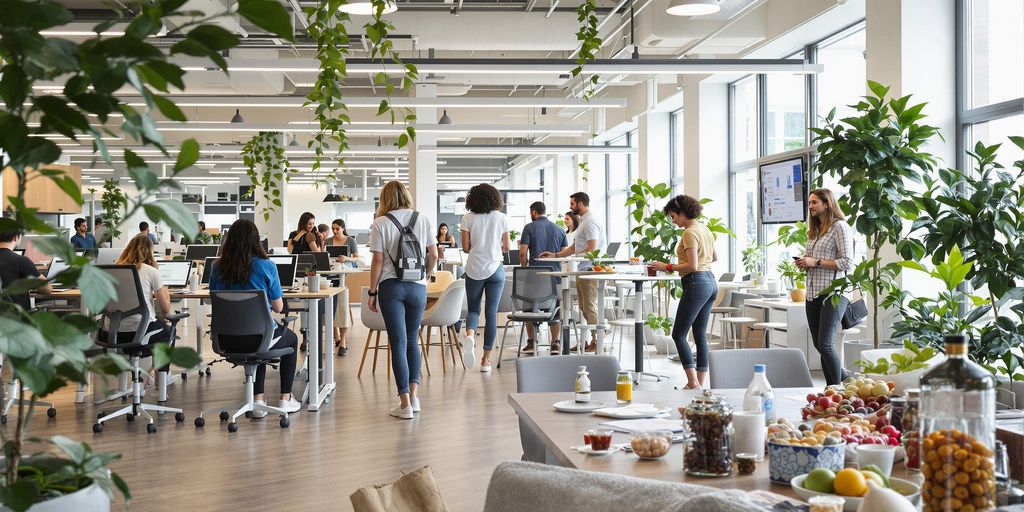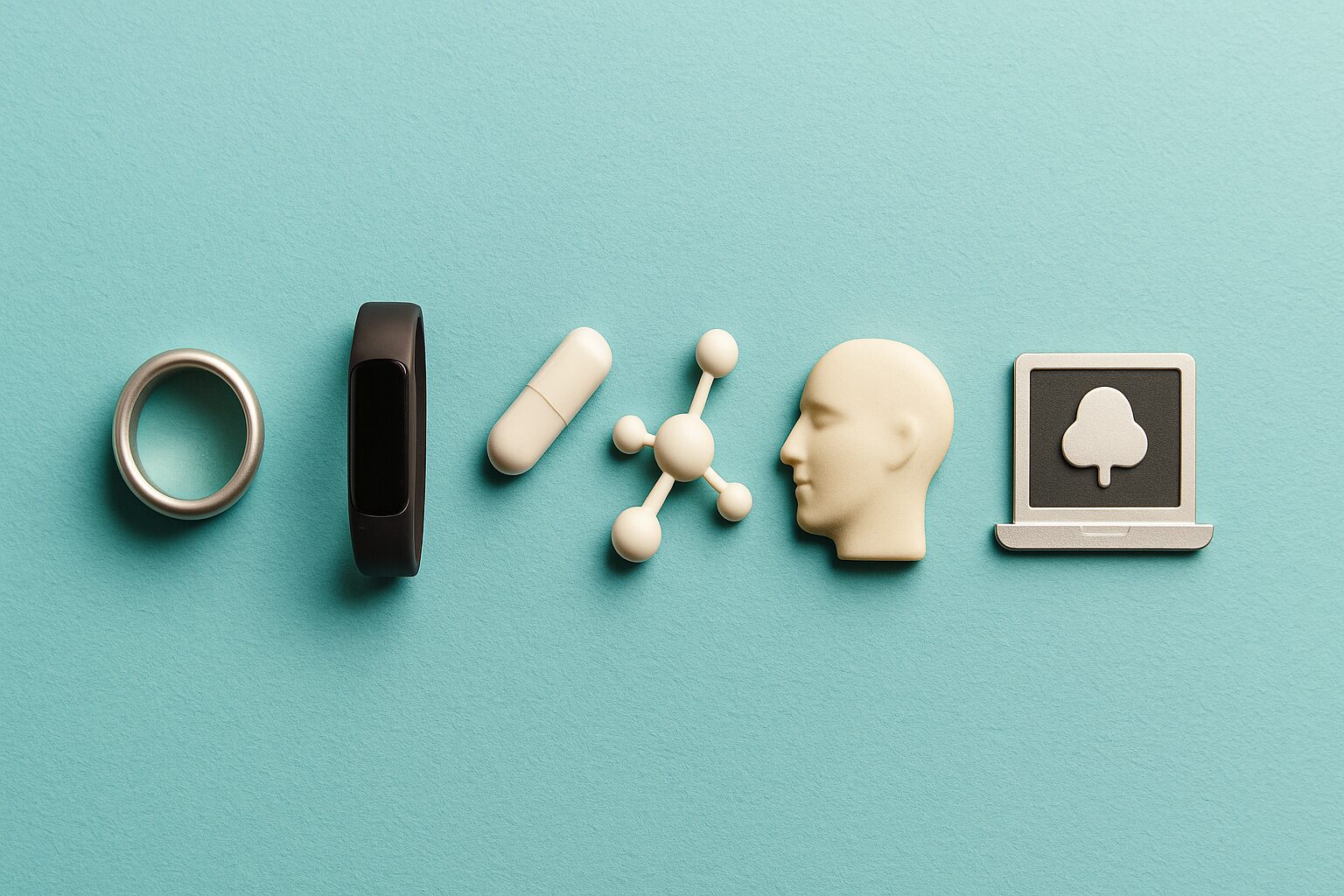In today’s fast-paced work environment, maximizing efficiency is more important than ever. One innovative approach gaining traction is biohacking in the office. This concept involves making small lifestyle changes to boost health and productivity. From workspace design to wellness practices, biohacking can transform how employees perform and feel at work. Let’s explore how these strategies can create a more productive and energized workplace.
Key Takeaways
- Biohacking in the office focuses on small changes that can lead to significant improvements in productivity.
- Creating a workspace that promotes focus and reduces distractions is essential for employee efficiency.
- Incorporating elements of nature and optimizing lighting can enhance mood and concentration.
- Encouraging healthy eating and regular movement is key to maintaining energy levels throughout the workday.
- Addressing employee concerns about biohacking is crucial for its successful implementation in the workplace.
Creating A Productive Workspace Through Biohacking
It’s time to rethink your office. Forget the drab cubicles and fluorescent lights. We’re talking about transforming your workspace into a biohacking haven, a place where your environment actively boosts your focus, energy, and overall well-being. The goal is to create a space that works with your body, not against it.
Designing for Focus and Clarity
Think about minimizing distractions. Open-plan offices can be great for collaboration, but terrible for concentration. Consider these:
- Dedicated quiet zones: Spaces where employees can retreat for focused work, free from interruptions.
- Noise-canceling solutions: Headphones, soundproof booths, or even strategically placed plants can help reduce ambient noise.
- Ergonomic assessments: Ensure workstations are properly set up to prevent physical discomfort, which can be a major distraction.
Incorporating Natural Elements
Bring the outdoors in! Studies show that exposure to nature can reduce stress and improve cognitive function. Here’s how:
- Plants, plants, plants: Add greenery to your workspace. Certain plants can even help purify the air.
- Natural light: Maximize access to sunlight. If natural light is limited, consider full-spectrum light bulbs.
- Nature-inspired decor: Use natural materials like wood and stone in your office design.
Optimizing Lighting Conditions
Lighting plays a huge role in our circadian rhythms and energy levels. You can use lighting to your advantage:
- Adjustable lighting: Allow employees to customize the lighting at their workstations.
- Blue light reduction: Minimize blue light exposure in the evening to promote better sleep.
- Circadian lighting systems: Implement lighting systems that mimic natural daylight patterns, promoting alertness during the day and relaxation at night.
Enhancing Employee Well-Being with Biohacking
It’s not just about getting more done; it’s about feeling good while doing it. Biohacking in the office can significantly improve employee well-being. By focusing on health and happiness, you can create a more engaged and productive workforce. It’s about making small changes that add up to big improvements in how people feel every day. Let’s explore some ways to make that happen.
Promoting Healthy Eating Habits
What people eat has a huge impact on their energy and mood. You can encourage better eating habits by:
- Stocking the break room with healthy snacks like fruits, nuts, and yogurt. Get rid of the junk food!
- Offering discounts on healthy meals from local restaurants. A little incentive can go a long way.
- Organizing group cooking classes focused on quick and nutritious meals. Make it fun and social!
It’s about making the healthy choice the easy choice. Think about providing filtered water and encouraging hydration strategies throughout the day. Small changes can lead to big improvements in overall health.
Encouraging Regular Movement
Sitting all day isn’t good for anyone. Here’s how to get people moving:
- Standing desks or desk treadmills. These are a great way to incorporate movement into the workday.
- Walking meetings. Get outside and get some fresh air while you talk.
- Scheduled stretch breaks throughout the day. Even a few minutes can make a difference.
Consider setting up a wellness challenge with prizes for most steps taken or minutes of activity. It’s all about making movement a part of the daily routine. You could even look into wearable devices for health tracking to help employees monitor their activity levels.
Implementing Mindfulness Practices
Stress can kill productivity and well-being. Mindfulness can help:
- Quiet spaces for meditation or relaxation. A designated area can make a big difference.
- Guided meditation sessions during lunch breaks. A little bit of calm can go a long way.
- Encouraging employees to take short breaks to practice deep breathing or visualization. It’s about finding moments of peace in a busy day.
Think about offering workshops on stress management techniques. Helping employees develop these skills can improve their overall well-being and reduce burnout. Remember, a calm mind is a productive mind. You can also introduce aromatherapy for mood enhancement to create a more relaxing atmosphere.
Utilizing Technology for Biohacking in the Office
Technology offers some cool ways to bring biohacking into the office. It’s not just about fancy gadgets; it’s about using tech to understand and improve how we work and feel.
Wearable Devices for Health Tracking
Wearable devices, like smartwatches and fitness trackers, can give you a ton of data about your body. This data can help you make informed decisions about your health and productivity. You can track things like:
- Heart rate variability (HRV) to gauge stress levels.
- Sleep patterns to optimize rest.
- Activity levels to ensure you’re moving enough during the day.
By monitoring these metrics, you can identify patterns and adjust your habits to improve your overall well-being. For example, if you notice your HRV is consistently low during certain tasks, you might need to rethink your approach to those tasks or incorporate more breaks.
Apps for Productivity Enhancement
There are a bunch of apps out there designed to boost your focus and productivity. Some popular options include:
- Focus apps: These apps block distracting websites and apps, helping you stay on task.
- Time management apps: These apps help you track how you spend your time, so you can identify time-wasting activities.
- Meditation and mindfulness apps: These apps guide you through meditation sessions, helping you reduce stress and improve focus.
These apps can be really helpful, but it’s important to find ones that work for you. Experiment with different options and see what helps you stay productive without feeling overwhelmed.
Virtual Reality for Stress Relief
VR isn’t just for gaming anymore. It can also be a powerful tool for stress relief. Imagine putting on a VR headset and being transported to a peaceful beach or a calming forest. Studies have shown that VR can reduce anxiety and improve mood. Some companies are even using VR to create immersive training programs that help employees develop coping mechanisms for stressful situations. It’s a pretty cool way to take a break and recharge during the workday.
The Role of Environment in Biohacking Success
Soundscapes for Concentration
Ever notice how much easier it is to focus in a quiet library compared to a busy coffee shop? That’s the power of soundscapes! Carefully chosen sounds can significantly impact your ability to concentrate and be productive. Think about incorporating white noise, nature sounds (like rain or birdsong), or even binaural beats into your workspace. Experiment to see what works best for you. Some people find music without lyrics helpful, while others prefer complete silence. It’s all about finding that sweet spot where distractions fade away and focus sharpens.
Aromatherapy for Mood Enhancement
Aromatherapy isn’t just about making your office smell nice; it can actually influence your mood and cognitive function. Certain scents have been shown to have specific effects. For example:
- Lemon: Energizing and uplifting.
- Lavender: Calming and stress-reducing.
- Peppermint: Improves focus and alertness.
Consider using an essential oil diffuser to subtly introduce these scents into your workspace. Just be mindful of your colleagues and any potential allergies or sensitivities. A little goes a long way!
Temperature Control for Comfort
Temperature might seem like a minor detail, but it can have a huge impact on your comfort and productivity. Being too hot or too cold can be incredibly distracting. Aim for a temperature that’s comfortable for you, ideally somewhere between 68-72°F (20-22°C). If you don’t have control over the thermostat, consider using a small personal fan or a space heater to adjust the temperature in your immediate area. Layering clothing can also help you adapt to changing temperatures throughout the day.
Addressing Concerns About Biohacking
Biohacking in the workplace can sound a little out there, right? It’s normal for employees to have questions or feel uneasy about it. Let’s tackle some common worries head-on.
Understanding the Science Behind Biohacking
It’s easy to dismiss biohacking as just another fad, but there’s real science involved. Many biohacks are rooted in established research about how our bodies and minds work. Think about it – we’ve always looked for ways to improve our lives, whether it’s through diet, exercise, or even just getting enough sleep. Biohacking takes a more intentional approach, using data and experimentation to find what works best for each person. For example, wearable devices can track sleep patterns, providing insights into how to optimize rest for better focus during the day. It’s not about turning into a cyborg; it’s about understanding your body better.
Debunking Myths and Misconceptions
There are a lot of myths floating around about biohacking. Some people think it involves extreme measures or risky experiments. That’s usually not the case in an office setting. We’re talking about things like optimizing lighting, encouraging hydration, or using aromatherapy – pretty tame stuff! Another misconception is that it’s all about forcing yourself to be more productive. Actually, it’s more about finding what your body needs to perform optimally. It’s about trusting that your gut and your heart always know what’s right for you. It’s not about pushing yourself to the limit; it’s about working with your body, not against it. Here’s a quick rundown of common myths:
- Myth: Biohacking is dangerous.
- Myth: It requires expensive equipment.
- Myth: It’s only for tech gurus.
Ensuring Employee Comfort and Consent
This is huge. You can’t just force biohacking on people. It’s all about creating a supportive environment where employees feel comfortable exploring these techniques. Open communication is key. Make sure everyone understands what biohacking is, what the potential benefits are, and what’s involved. It’s also important to respect individual preferences. Not everyone will be on board with every biohack, and that’s okay. The goal is to empower employees to make informed choices about their own well-being. Maybe start with a survey to gauge interest and identify areas where people are already struggling, like energy levels or stress management. Then, offer a range of options and let people choose what works for them. Remember, the aim is to create a more favorable working environment, not a mandatory science experiment.
Biohacking Techniques for Energy Management
Let’s face it, the workday can be a real energy drain. You’re probably looking for ways to stay sharp and focused without crashing halfway through the afternoon. Biohacking offers some interesting approaches to managing your energy levels throughout the day. It’s all about understanding your body and finding what works best for you.
Hydration Strategies for Optimal Performance
Staying hydrated is absolutely key for maintaining energy levels. It’s easy to forget to drink enough water when you’re busy, but even mild dehydration can lead to fatigue and decreased cognitive function. I try to keep a water bottle at my desk and sip on it throughout the day. Some people swear by adding electrolytes to their water, especially during those afternoon slumps. I’ve also found that herbal teas can be a nice alternative to water, plus they can offer additional benefits depending on the type of tea.
Nutritional Biohacks for Sustained Energy
What you eat has a huge impact on your energy levels. Forget those sugary snacks and processed foods that give you a quick boost followed by a major crash. Instead, focus on whole, unprocessed foods that provide sustained energy. Here’s a simple table illustrating the impact of different food choices:
| Food Type | Energy Impact | Additional Benefits |
|---|---|---|
| Sugary Snacks | Quick boost, then crash | None |
| Whole Grains | Sustained release | Fiber, vitamins, minerals |
| Healthy Fats | Long-lasting energy | Brain function, hormone production |
| Lean Protein | Steady energy | Muscle repair, satiety |
Also try to incorporate these into your daily routine:
- Prioritize protein: Start your day with a protein-rich breakfast to keep you feeling full and energized.
- Embrace healthy fats: Add avocado, nuts, or seeds to your meals for sustained energy.
- Limit processed foods: These can lead to energy crashes and inflammation.
Sleep Optimization for Better Focus
Okay, this one might seem obvious, but it’s so important that it’s worth repeating. Getting enough quality sleep is crucial for energy management and overall well-being. When you’re sleep-deprived, your body struggles to function optimally, leading to fatigue, brain fog, and decreased productivity. Aim for 7-9 hours of quality sleep each night. I’ve been working on improving my sleep hygiene by creating a relaxing bedtime routine, making my bedroom dark and quiet, and avoiding screen time before bed. It’s made a noticeable difference in my energy levels and focus during the day.
Here are some things that have helped me:
- Consistent Sleep Schedule: Go to bed and wake up around the same time every day, even on weekends.
- Optimize Sleep Environment: Make sure your bedroom is dark, quiet, and cool.
- Limit Screen Time Before Bed: The blue light emitted from screens can interfere with sleep.
Fostering a Culture of Biohacking in the Workplace
It’s one thing to introduce biohacking techniques, but it’s another to make them stick. To really see the benefits, you need to build a workplace culture that supports and encourages these practices. Think of it as planting seeds – you need the right soil for them to grow.
Encouraging Open Discussions on Health
Start by creating a safe space where people feel comfortable talking about their health and well-being. This could involve regular team meetings where you discuss biohacking strategies, share experiences, and address any concerns. The goal is to normalize these practices and make them a part of the everyday conversation. Don’t be afraid to share your own experiences, even if they’re not perfect. It’s all about learning and growing together.
Training Programs for Biohacking Techniques
Don’t just throw a bunch of information at your employees and expect them to figure it out. Offer structured training programs that teach them the science behind biohacking and how to implement different techniques safely and effectively. This could include workshops on nutrition, sleep optimization, or stress management. Make sure the training is practical and relevant to their daily lives. For example, a workshop on desk ergonomics could teach employees how to set up their workstations to minimize strain and maximize comfort.
Creating Supportive Peer Networks
Encourage employees to form small groups or buddy systems where they can support each other in their biohacking journeys. These networks can provide accountability, motivation, and a sense of community. Maybe a group of people want to try intermittent fasting together, or perhaps they want to start a walking club during lunch breaks. The key is to create opportunities for people to connect and share their experiences. This can be as simple as setting up a dedicated Slack channel or organizing regular coffee breaks where people can chat about their progress.
The Future of Biohacking in the Workplace
In conclusion, biohacking is more than just a trend; it’s a practical approach to improving how we work and feel in the office. By making small changes, like adjusting our environment or tweaking our routines, we can see big boosts in productivity and well-being. Companies like Monrow Shoes are already reaping the benefits, showing that when employees feel good, they perform better. So, whether it’s through scents, light adjustments, or simply taking breaks, there are plenty of ways to incorporate biohacking into daily work life. The key is to find what works for you and your team. As we move forward, embracing these innovative strategies could be the game-changer for workplace efficiency.
Frequently Asked Questions
What is biohacking in the workplace?
Biohacking in the workplace means making small changes to improve health and productivity. This can include diet changes, exercise, and using technology to track health.
How can I create a better workspace using biohacking?
You can improve your workspace by adding plants, using good lighting, and reducing noise. These changes help you focus better.
What are some simple biohacks for staying energized at work?
Drink plenty of water, eat healthy snacks, and take short breaks to move around. These habits can keep your energy levels high.
Is technology helpful for biohacking?
Yes! Wearable devices can track your health, and apps can help you manage your time and tasks better, making you more productive.
What should I do if I have concerns about biohacking?
If you’re worried, talk to your employer about it. It’s important to understand how biohacking works and to ensure everyone feels comfortable.
How can I promote a culture of biohacking at work?
Encourage open discussions about health, provide training on biohacking techniques, and create support groups among coworkers.




